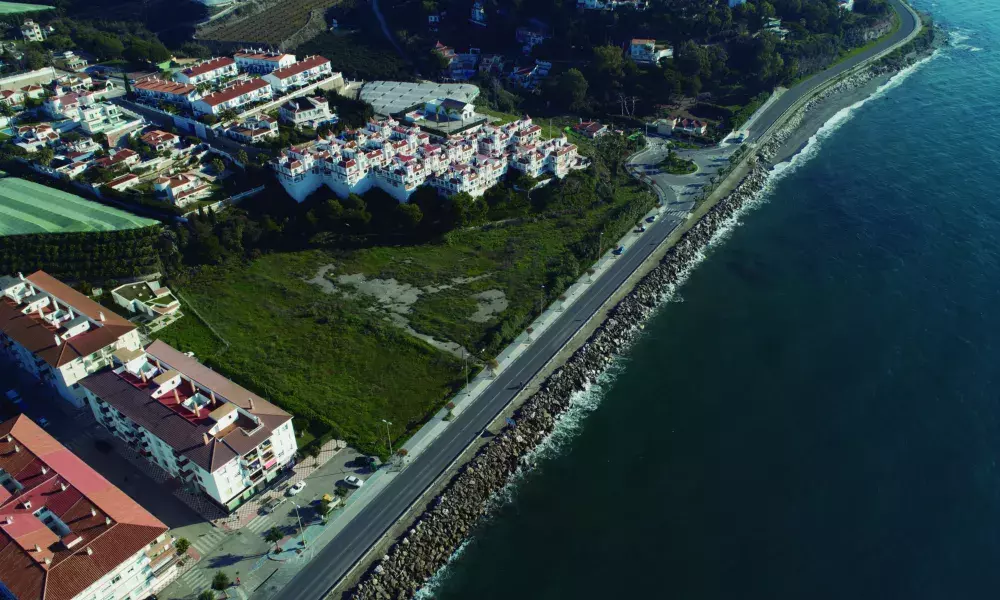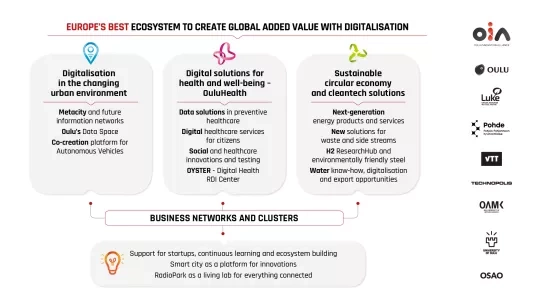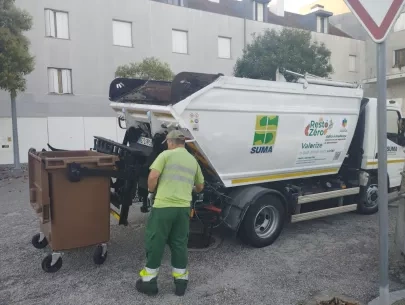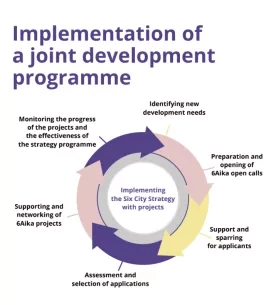
Since its inception, the BRICK-BEACH project has been the subject of a series of issues of various kinds. In addition to the complexity that a circular economy project represents, it is necessary to take into account the need to carry out different infrastructure works, the legal authorizations of various administrations at the local, regional and national levels, and the coordination of partners with different cultures and their internal procedures, among other aspects. However, the biggest challenge that the project has faced, without a doubt, is the lack of a shared vision in the Vélez-Málaga City Council, leader of the project, regarding the objectives and results of the BRICK-BEACH initiative.
The BRICK-BEACH project revolves around three main components: the first, which can be considered the project’s engine, consists of constructing a waste recycling plant that would have to supply the necessary material to recover a currently non-existent beach that disappeared in the 70s. The second is the work in the northern area of the beach to turn it into a recreation area, including an administrative building that should host sustainable business initiatives. Finally, the works aim at preventing the tides from destroying the recovered beach with dikes below sea level and located about 100 meters from the beach.
As is easily imaginable, the administrative tasks related to the preparation of the relevant tenders and the environmental authorizations have been, and continue to be, one of the most challenging tasks of the project, which is at the origin of the two extensions of the project, along with the problems arising from COVID-19. In this sense, the cooperation, professionalism and efficiency of the technical teams' partners can be defined as exemplary in every way. However, as has been repeatedly mentioned in previous Journals, the most crucial difficulty leading to a practical blockade is the City Council's lack of agreement on the recycling plant's location and management model. This lack of definition and manifest disagreement has led the highest political representative in charge of the project to present her resignation as head of the BRICK-BEACH project. That is, unfortunately, the current situation. However, what is most surprising is the absence of a determined political initiative that could give a new impetus and continuity to the project. Given these circumstances, the future and viability of the BRICK-BEACH project, as originally conceived, is more than ever at risk.
The purpose of this Zoom-in is to highlight, through the responses of the project partners, its potential, the critical moment in which it finds itself and the need for robust and determined leadership that can lead the project to a good end.
Interviewer: Miguel Lucena (M.L.) Interviewee: Pablo Fernández (P.F.) Director of Strategic Projects City Council of Vélez-Málaga
The BRICK-BEACH project has been subjected to a set of administrative issues that have made it necessary to request an extension to the European Union authorities for its completion. Taking into account the above,
M.L.: How do you assess the project's current state as a whole?
P.F.: First of all, I would highlight the important involvement of the partners and the quality of their work. At a technical level, the necessary projects and tests have been carried out to obtain the administrative authorizations, which has allowed us to demonstrate the viability of the proposed project. We are satisfied because the knowledge acquired during the development of this Initiative can be applied in different places, offering a novel solution in managing construction and demolition waste for the regeneration of beaches.
M.L.: Are you ready to complete all work packages by the established date?
P.F.: The complexity of the project and the delay in administrative procedures, including those derived from the general health situation, have prevented the project's execution from being completed, so the current feeling in this regard continues to be one of uncertainty. We continue to work to achieve the highest degree of implementation possible.
M.L.: What aspect would need to be improved or modified to bring the project to a successful conclusion?
P.F.: It does not seem that the climate challenge and the circular economy are central axes of government actions. Citizens are aware but perceive it as something distant that could be postponed or developed in other scenarios. On the other hand, after three years of administrative procedures, the authorization of Coasts (the national public administration) has not yet been completed. It is urgent to support public administrations with the personnel and training necessary to speed up the processes that allow the planned investments to be completed.
M.L.: How do you assess the reaction of civil society to BRICK-BEACH?
P.F.: In general, the project's reception has been very positive. Numerous associations and technicians from very diverse backgrounds continue to be interested in it. At the local level, greater involvement of the younger strata of society, more aware of environmental problems and with a greater capacity for illusion, is perceived. On the other hand, a certain resignation is observed in front of the problems in the sectors with the most significant capacity for action, even in the groups directly benefited by the investments, which is logical in processes that are so long in time.
If the regeneration of Mezquitilla beach is not carried out
M.L.: What palliative measures could be implemented?
P.F.: We hope that the plant's construction can guarantee the future regeneration of the Mezquitilla beach with recycled aggregates, even after the execution period of the obtained subsidy has passed, thanks to its economic viability.
Interviewer: Miguel Lucena (M.L.) Interviewee: Juan de Dios Mellado (J.D.M.) Agencia de Medio Ambiente y Agua
The package of activities of the BRICK-BEACH project regarding the tides, beach and adjacent area is one of the most complexes. It has required a more significant administrative effort, previous studies and analyses. These efforts have finally had their reward with obtaining the unified environmental authorization by the competent authorities. In this context,
M.L.: What are the biggest challenges you face in carrying out your work package?
J.D.M.: One of the biggest challenges has been the complexity of drafting the project, embedded in a multifunctional field (Environmental, Marine Environment, Coastal Dynamics, etc.). The proposal is truly innovative since no regulations establish, nor formulations that model, the behaviour of recycled aggregates in coastal dynamics. Therefore, the project's materialisation is also the seed of new regulation of greater scope than the existing one.
M.L.: Do you think you are in a position to complete these tasks by the project deadline?
J.D.M.: We estimate that the project management for the beach's regeneration will not be carried out within the remaining time of the project since it will be necessary to build the CDW plant for the eroded recycled aggregate to arrive and for the free dikes to be made. As for the parcel north of the N340a, we cannot yet comment.
M.L.: What measures should be adopted to ensure the sustainability of the planned actions?
J.D.M.: Once the planned actions have been carried out, a maintenance and control plan of all kinds must be carried out, including environmental ones, the guarantee of aggregate supply, etc.
Interviewer: Miguel Lucena (M.L.) Interviewee: Xavier Niell (X.N.) Department of Ecology and Geology Professor
The work of the University of Malaga within the BRICK-BEACH project has been key to achieving a gravel production system from construction waste suitable for use in the regeneration of Mezquitilla beach. However, some question the viability of such a system and obtaining the right beach product.
M.L.: What can be argued against such criticism?
X.N.: In reality, we are unaware of such criticism, either because of our constituency in the scientific circles or because of a lack of curiosity on our part. However, we are willing to respond to the considerations that may be made about the work of UMA+ AGRECA from which the technical decisions adopted with scientific criteria. The publication of the results and their discussion in a scientific journal, Resource, Conservation and Recycling, attributes solidity and proven quality to our study since up to five experts in the material have evaluated the work in said journal.
M.L.: What assessment do you make of this publication?
X.N.: There are objective criteria to know the journal Resource, Conservation and Recycling value. It has an impact index of 10.2.
M.L.: How do you assess the possibility of reusing construction waste to regenerate degraded/eroded coastal areas from a scientific point of view?
X.N.: Brick-Beach will establish efficiency criteria during its development; this is one of its purposes. If its development continues, as far as it goes, it will allow the evaluation of environmental impacts, social acceptance and efficiency in the destination of funds. The essential thing is that materials are deposited in Mezquitilla to have empirical results.
M.L.: What impact do you think a project like BRICK-BEACH can have at a national or European level?
X.N.: It is an applied type project that has been developed in its technical part with rigorous criteria, which has made it possible to decide on a protocol among various options. The development has been done publicly, and that is, the transfer of the "know-how" is assured. Following the Brick-Beach protocol exactly is one option among others. We insist that it could be developed identically or differentially with modifications concerning Brick-Beach according to scientific criteria or convenience in other EU member states.
Interviewer: Miguel Lucena (M.L.) Interviewee: Juan Jesús Martín (J.J.M.)v
Aula del Mar is in charge within BRICK-BEACH of carrying out the dissemination and training tasks of the project with particular emphasis on the education, training and civil society sector as a whole.
M.L.: How do you assess the society's receptivity as a whole to the BRICK-BEACH project to date?
J.J.M.: We believe that, currently, a majority sector of local society still has doubts about the viability of this innovative and complex project, mainly because they do not perceive a political determination for its execution; however, they are convinced of the general socio-economic and environmental benefits of the BRICK-BEACH project for their municipality. In all the activities carried out to publicize the project, we attempt to inform and voice the different citizen groups about their opinion and proposals to optimize the new coastal space to be recovered. In the meetings with the numerous and different participants (conferences, workshops, meetings, interviews, etc.), their first reaction was disbelief, remembering what that environment was like in the past, ending with expectations and claims to recover that beach.
M.L.: What has been the reaction of primary school students to the BRICK-BEACH project?
J.J.M.: The reception of the BRICK-BEACH project by the educational community of Vélez-Málaga has been highly gratifying, thanks mainly to the teachers who did not hesitate to open their classrooms to us, sensitized from the beginning with the environmental problems raised and supporting the initiative proposed in this project. It has been possible for more than 2,000 primary and secondary school children, corresponding to 17 educational centres, to participate in workshops designed with an agile and didactic proposal. In addition, once this phase is over, the students have been able to compete, together with the invaluable help of their educators, in the elaboration (with recycled materials) of different proposals for "mascots" as possible identifying images of BRICK-BEACH.
M.L.: What are the most exciting business projects that could be welcomed in the administrative centre to be built in the northern area of Mezquitilla beach?
J.J.M.: The entrepreneurs who have participated in the Training and Orientation Programme of the BRICK-BEACH project, developed jointly between Aula del Mar and the University of Malaga, have presented projects of sustainable socio-economic activities related to the blue economy to be developed from the logistics base of the planned administrative centre in the northern zone of Mezquitilla beach.
Among the projects presented, the performance of sports activities with low environmental impact for the enjoyment of the coastal and underwater landscape (kayaks, paddle surfing, diving, etc.), local gastronomic tourism activities related to the local fishing and fruit and vegetable sector, environmental education activities aimed at school groups and also coastal recreational activities during vacation times (camps, cultural and ecological days), as well as the creation of a blue sea interpretation centre (interactive museum exhibition related to marine fauna, fishing gear and gear, and the traditional navigation).
BRICK-BEACH has in its design a vital component related to the recovery of a currently disappeared beach. Given the current difficulties of the project,
M.L.: How do you think potential users, residents of the area and, in general, society might react to the absence of the announced beach?
J.J.M.: Aula del Mar in Malaga has made a great effort for citizen involvement in the BRICK-BEACH project. With this objective, educational workshops, environmental conferences, and numerous informal meetings have been carried out and compiled proposals with citizen groups (neighbourhood, environmental, academic, business, foreign residents, fishermen, cultural and sports associations).
This unique coastal rehabilitation project created great expectations for three consecutive years. Therefore, we believe that the population of Vélez-Málaga and especially the residents of the area would be frustrated if the announced beach does not materialize, even if it is beyond the deadlines of the BRICK-BEACH project.
Interviewer: Miguel Lucena (M.L.) Interviewee: Pablo Pérez (P.P.) AGRECA Manager Association of Management Companies of Construction Waste and Demolition of Andalusia
The construction of the waste recycling plant is one of the fundamental elements of the BRICK-BEACH project. Given the controversy surrounding its location, in which, despite its location being decided from the beginning of the project, a disagreement on said location by the same government team that leads the BRICK-BEACH project,
M.L.: What assessment do you make regarding the viability of the project if the initial location of the plant is not maintained?
P.P.: The plant's location could be moved to any existing plot in the municipal territory of Vélez-Málaga, provided that it has a minimum area of 15,000.00 m2, has an urban qualification compatible with the activity, and accesses to essential services (water, electricity, etc.).
M.L.: Would it be feasible to consider a new location given the necessary administrative requirements?
P.P.: In our opinion, this is why a change of location makes the project unfeasible. The deadlines for obtaining a unified environmental authorization by the Ministry of Agriculture, Livestock, Fisheries and Sustainable Development of the Junta de Andalucía exceed one year, so it would be impossible to meet the established deadlines.
M.L.: Is there an alternative technical and economically viable solution to building the plant at the initial location?
P.P.: From our point of view, it is not very easy. The planned installation could be considered in an already authorized private plot. Still, since there is none in the municipality of Vélez-Málaga, the long-distance would considerably increase the unit cost associated with transport, both of the waste and the recycled aggregates produced; therefore, the feasibility of the installation in relation to the municipal term would be greatly diminished. That is to say, the technical feasibility is possible, although not the economic one.
The conclusions that we can reach after almost four years of development of this project are diverse and varied and can be summarized as follows:
- The BRICK-BEACH project has aroused and continues to arouse great interest on the part of citizens as a whole and in the rest of the regions and even in other countries of the European Union. A circular economy project that combines at the same time the response to an endemic problem in a tourist area such as the lack of adequate treatment of construction waste, an ingenious solution to have a product that serves to recover a lost beach and sustainable and innovative use of an area linked to economic and coastal life.
- One of the most complex challenges that the project has had to solve has been obtaining the pertinent administrative authorizations (environmental, coastal, etc.). The involvement of different administrations at different levels (local, regional, national), the electoral processes carried out in recent years, and the impact of COVID-19 have certainly been elements that have not helped obtain these authorizations in a reasonable time.
- A seamless level of commitment and high professionalism characterizes the technical team responsible for the development and implementation of the project. Without a doubt, this can be considered the strongest point of the project from the point of view of its administrative structure.
- Unfortunately, the project has basically suffered from poor leadership on the part of the project's governing body, which has been clearly reflected in the lack of agreement in the government team of the Vélez-Málaga City Council on the location of the recycling plant. The curious thing is that the same government team presented the proposal for the BRICK-BEACH project and that, now, in October 2021, a few months before the end of the project, it questions its location and management model.
- Notwithstanding all of the above, there is still hope that there will be a radical change in the current blockade situation in terms of the recycling plant. If it were to occur, there is no doubt that the project would be ready to be carried out, if not in its entirety, then a substantial part of it.
About this resource
The Urban Innovative Actions (UIA) is a European Union initiative that provided funding to urban areas across Europe to test new and unproven solutions to urban challenges. The initiative had a total ERDF budget of €372 million for 2014-2020.
Similar content




